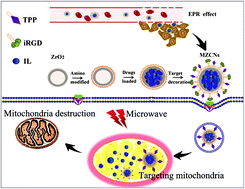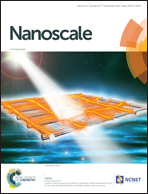Mitochondria-targeting nanoparticles for enhanced microwave ablation of cancer†
Abstract
Although microwave ablation is widely used in the treatment of hepatocellular carcinoma, it is only recommended for the therapy of cancer with a diameter of 3 cm or less because of the limited heat transmission radius. Mitochondria play an important role in the apoptotic events of tumor cells. Here, we developed mitochondria-targeting zirconia (ZrO2) complex nanoparticles (MZCNs) as nanoagents for efficient cancer therapy by microwave ablation. The MZCNs are composed of ZrO2 nanoparticles encapsulating the microwave-sensitive ionic liquid (IL) and co-decorated with the mitochondria-targeting molecule of triphenylphosphonium (TPP), and the tumor cell-targeting peptide iRGD. The cell experiment results reveal that the amount of MZCNs accumulated in the tumor is obviously increased by the synergistically targeted delivery of TPP and iRGD peptide after administration by intravenous injection. Besides, the in vitro experiments demonstrate that MZCNs are distributed preferentially in the mitochondria with the assistance of TPP molecules. More importantly, the in vivo experiments in mice administered with MZCNs show that the effective area with a temperature above 42 °C was about 2.8-fold larger than that of the controls due to the targeting effect and better microwave sensitivity of the MZCNs. As such, the cancer in mice can be eradicated without recurrence, demonstrating the MZCNs as promising nanoagents for efficient cancer therapy by microwave ablation.



 Please wait while we load your content...
Please wait while we load your content...